Kids on Target
Guns on campus? You bet, and nobody is complaining - parents included - as high school air riflery teams grow in popularity, especially with girls. In a few days, the OIA air rifle season will come to its conclusion.
By Brandon Bosworth
E-mail this story | Print this page | Archive | RSS
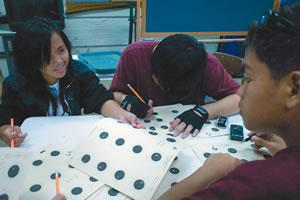
|
In a few days, the OIA air rifle season will come to its conclusion. The season began in late August, and will soon end with young shooters from Radford and Waialua high schools facing off in a battle of skill and accuracy.
Though lacking the hype and publicity of other OIA sports such as baseball, basketball or the gambler’s favorite, football, air riflery has managed to carve out its own little niche while attracting a somewhat different type of athlete.
“Our shooters are quiet, introverted types,” says Francis Achiu, coach of Moanalua High’s team. “They are more inner focused, very academic.”
According to Achiu, many of his team’s members are not particularly athletic in a traditional way, and are drawn to air rifle shooting because they want to compete in a sport that doesn’t require purely physical attributes, such as speed or brute strength. Actually, a bookish nature can be a benefit. “Shooting the air rifle requires mental discipline, patience and concentration,” says Achiu, “If you’re not in control, you’ll miss the shot.”
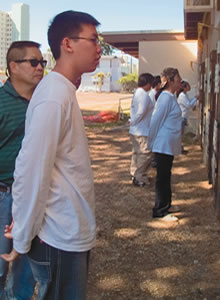
|
Perhaps the unusual nature of air riflery explains why the sport seems to hold particular appeal for girls. Though not all schools have large numbers of female team members, at Moanalua they account for about half of the 24 shooters. The team’s top shooter, junior Chelsie Hata, has been competing since she was a freshman, and is perfectly frank about one of the reasons she chose to take up air riflery: “I’m unathletic and wanted a sport where I didn’t have to run.” Plus, she “just likes guns” and hopes to eventually compete with rimfire rifles.
Are people ever put-off by the notion of a teenage girl whiling away her time in competitive shooting? “Not really,” says Chelsie. Her teammate, senior Robyn Vea, chimes in, noting, “When other students see us in our team shirts, they get excited and start asking questions about the team and how to sign up.”
Different schools, however, can attract different types of shooters. The team at Farrington High, for example, “doesn’t have many girls,” according to coach Bruce Tagama. “Most of our shooters come out of the Junior ROTC program,” he explains.
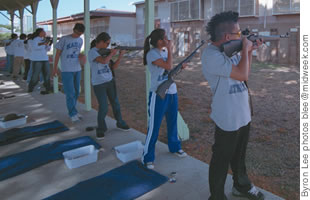
|
The trait which really sets competitive shooters apart, observes Tagama, is determination. “When they start in the sport, most kids aren’t really as good of shooters as they think they are,” he says. “It takes determination to get beyond that and improve.”
In the past, if local schools had any sort of shooting sports program, it was affiliated with JROTC.
“In the early ‘90s, we used to have a handful of schools with target shooting teams,” says OIA executive director Dwight Toyama. “They were mostly sponsored by the JROTC.” Teams competed with .22 caliber rimfire rifles, which were more expensive than the air rifles more commonly used today. “We were able to get more schools involved by having air rifle competitions, and we don’t have to rely on JROTC sponsorship.” Today, most Oahu high schools have an air rifle team.
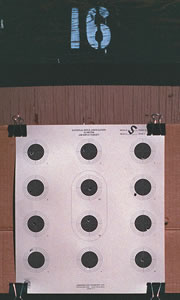
|
The response to the air riflery programs has been very positive. Surprisingly, given the age we live in, there has been no negative reaction from the anti-gun side of the political spectrum.
“Since I came aboard in 1990,” says Toyama, “I haven’t heard any complaints.” Coaches Achiu and Tagama concur. “There’s not been any controversy,” according to Achiu.
One factor leading to the sport’s acceptance may be the heavy emphasis on safety. During competition, detailed instructions are given at virtually every stage of the event, with team members told exactly when to unfurl their shooting blankets, when to remove their rifles from their cases, when to load them, and so on. It makes the process rather slow, with meets lasting up to three hours, but very safe. So serious are the coaches and organizers about safety, it was actually difficult for MidWeek photographer Byron Lee to get shots because no one wanted to allow him near the shooting line.
Not having to worry about the risks helps parents to be fully supportive of their kids’involvement in the sport. Jan Inn, whose son Matthew is on the Moanalua team, says she was “very glad he got involved ... it gives him motivation and forces him to keep his grades up.” Fellow Moanalua mom Laurie Okamura adds that air riflery is very good for her son Erik, too, as it stresses positive character traits. “It requires lots of concentration, focus and patience.”
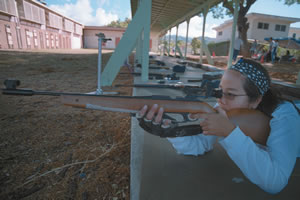
|
Like team shooter Robyn Vea, people often ask her about the program. “Most parents aren’t aware of the air rifle team,” says Okamura. “When they learn about it, they ask how their kids can get involved.”
Though this season of air rifle competition will soon end, the future for the sport appears bright. The enthusiasm of both the kids and their parents seems to guarantee it. After all, how many OIA sports can attract both the future military leaders of the ROTC and self-described “unathletic” introverts? And in how many sports can the unathletic types dominate?
Page 1 of 1 pages for this story
E-mail this story | Print this page | Comments (0) | Archive | RSS
Most Recent Comment(s):








